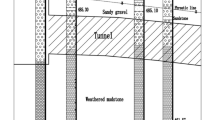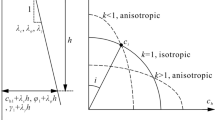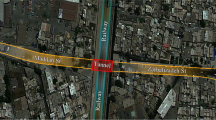Abstract
In the last many decades, replying to the urgent needs for the infrastructure construction, shield tunneling has been conducted widely in urban areas. Although the technique has been advanced recently owing to the accumulation of practical experiences and the progress of mechanization, there still remains many unknown problems especially in soft ground tunneling. For tunneling, one must always consider not only the stability of a tunnel itself but also the surface settlement due to deformations of soil around the tunnel. Although the patterns of the surface settlements differ for different soil conditions and methods of tunneling, many field observations and model tests show that the troughs of surface settlement can be approximated by the error functions or Gaussian normal distribution curves. This article concentrates on analyzing passive failure and deformation mechanisms of the soil in front of tunnel face due to tunneling.
Access provided by Autonomous University of Puebla. Download conference paper PDF
Similar content being viewed by others
Keywords
1 Introduction
Finite element method (FEM) has now been improved and widely used to solve complex elasticity, elasticity–plasticity, and adhesion–plasticity problems. Its advantages due to discontinuity and heterogeneity of stratigraphic structure can handle complex boundary conditions to calculate the stress–strain value and their distribution. Based on that, it is used to analyze the passive failure mechanisms [1].
Once finding out, numerical analysis was a design tool though it was often criticized. However, thanks to the development of information technology, a revolution on the field of underground engineering has taken place so far. From that, tunnel works are calculated with complete numerical analysis.
The convenience of numerical analysis method has been proved. Both material behaviors and boundary conditions have been included in the calculation and parameters study to improve for the tunnel design in order to make it easier.
Currently, there are several available programs for calculating underground structures on the world such as: SAGE CRISP developed by the Crisp Consortium Ltd; PLAXIS developed by PLAXIS BV Ltd.; SIGMA module in GEOSLOPE program developed by GEOSLOPE-International Ltd.; and MISES program according to NATM. These programs all use FEM to calculate the problems of underground works. These tools are quite effective for consultancy agencies to evaluate design and conduct research on underground works as well.
This paper applies FEM, which simulates on PLAXIS program and aims to analyze the passive failure and deformation mechanisms of soil in front of tunnel face during the process of constructing [2,3,4].
2 Establishing the Numerical Modeling
3 Numerical Model Procedures
Each analysis is started by applying an acceleration of 100 g. This is achieved by increasing the soil’s specific weight 100 times [5]. The analyses were carried out by assuming that the deformation of the soil increases by g times in one-dimension, the horizontal coefficient of effective vertical stress is K0. Thus, the initial stress state of soil layers at 100 g acceleration can be determined. For tunnels in sand, this represents a condition when equilibrium is reached. In centrifugal model experiments, the presence of the model tunnel will redistribute stress around tunnel. Besides, an ideal condition with no side friction is also simulated [6, 7].
The tunnel is assumed to be placed on-site and submerged in water. Excavation is simulated by disabling soil elements in the tunnel area and activating the sheet elements of the tunnel cover in the same time. A constant pressure, which is equal to the static soil pressure at the center of the tunnel, is applied to the tunnel. It should be noted that the tunnel moves away from the soil by g times so K0 cannot be reached immediately before the passive failure experiment.
A margin to control pressure was placed in the tunnel to determine the passive failure pressure, similar to tunnel construction with shields in practice. For tunnel in sand, drainage is analyzed. In other words, the slow speed is built up to entirely dissipate the excess pore water pressure.
4 Result Analysis
4.1 Failure Mechanism
Figures 3a–d and 4a–d show us the vector of ground displacement in the position of C/D = 1.5 and 3.3. From the simulation results, displacement vectors show a funnel-shaped failure mechanism [8]. The mechanism is similar to the localized failure mechanism. The result of simulation shows that the soil elements in front of the tunnel and far away the tunnel affect the soil ground and forms the failure areas.
4.2 Passive Failure Pressure
The passive failure pressure in front of tunnel is calculated by finite element method and synthetized in Table 2.
Compared with results in the centrifugal experiments T1 and T2 conducted by Tuan et al. [9], Wong [10], the pressure curves calculated by finite element method recognize a similar trend but with the smaller value.
For centrifugal and numerical analysis experiments, we find that in case tunnels located at C/D = 1.5, the soil in front of the tunnel face is shifted forward, whereas the soil in regions located further away from the tunnel axis is forced outward. It is observed that the funnel-shaped failure mechanism is narrower than a five-block failure mechanism, which is assumed in existing upper-bound solutions. However, the analyses of passive failure pressures by the upper-bound solutions are reasonably consistent with the measured tunnel pressure. In addition, the displacement pressure curves in finite element method are appropriate with the measured results.
In case the tunnel is placed at C/D ratio is 3.3, soil displacement is limited around the vicinity of the tunnel mirror as it moves forward and a localized failure mechanism related to ground deformation is observed. The tunnel failure pressure in finite element method is smaller than corresponding value (9.4–48.4%) for the C/D ratio is 1.5 and (3.6–25.4%) for the C/D ratio is 3.3. However, it can be seen that there is a correlation of the passive failure pressure in the centrifugal experiment and the finite element method (Fig. 5) [1, 9,10,11].
4.3 Ground Displacement
The ground displacement in front of tunnel is analyzed by finite element method as shown in Figs. 6 and 7.
In case the tunnel is located at C/D ratio is 1.5, it can be seen that the soil in front of the tunnel face is shifted forward which makes it to be compressed and causes the surface to be exposed. As a result, the funnel-shaped failure is formed.
When the tunnel depth increases (C/D = 3.3), the deformation zone is found to be significantly larger and the range of influence is wider accordingly. The stresses in the surrounding site of the tunnel rise, which makes the sand be less pushed up. As a result, it will be compressed in front of the tunnel. The largest displacement is located near the original position of the tunnel, but its value is lower than the ground displacement around the tunnel in which the C/D ratio is 1.5.
The calculation results of soil deformation in finite element method show a similar figure with centrifugal tests, expect for the wider range of influence. Besides, the curve graph of ground displacement from all of methods is a similar shape with the Gaussian curve proposed by Peck and Schmidt [12].
5 Conclusions
There is analogy between funnel-shaped failure mechanism and localized failure mechanism soil in front of the tunnel face. The results of the study show that the soil elements in front of the tunnel face and at the far side of the tunnel which effects on the ground surface form a failure area around the tunnel.
The results of failure mechanism in finite element method show a higher figure than in centrifugal tests. One of the reasons is possibly due to the maximum expansion angle which is acceptable when soil elements follow the failure mechanism in numerical simulation.
Compared to the measurement results in centrifugal tests, the curves of passive failure pressure in finite element method show a similar trend, but with a lower value. The reason is that the data in the centrifugal tests was affected by friction between the tunnel and pads, glass or sand. However, this effect is not included in the numerical analysis process.
The value from failure pressure mechanism in finite element method is lower than the measured value (9.4–48.4%) for the C/D ratio is 1.5 and (3.6–25.4%) for case C/D 3.3, respectively. However, it can be seen that there is a correlation between the passive failure pressure in centrifugal tests and in finite element method.
As the tunnel moves ahead, the soil in front of the tunnel face is shifted forward accordingly which makes it to be compressed and causes the surface to be exposed. As a result, the funnel-shaped failure is formed. As the depth of tunnel increases, the deformation zone is found to be significantly larger and the range of influence is also wider.
References
Soubra, A.H., Dias, D., Emeriault, F., Kastner, R.: Three-Dimensional Face Stability Analysis of Circular Tunnels by a Kinematical Approach, pp. 894–901. Geotechnical Special Publication (2008)
Chambon, P., Corte, J.F.: Shallow tunnels in cohesionless soil: stability of tunnel face. J. Geotech. Eng.-ASCE 120(7), 1148–1165 (1997)
Loganathan, N., Poulos, H.G.: Analytical prediction for tuinnelling—induced ground movements in clays. J. Geotech. Geoenviron. Eng. ASCE 124(9), 846–856 (1998)
Oblozinsky, P., Kuwano, J.: Centrifuge experiments on stability of tunnel face. Slovak J. Civ. Eng. 3, 23–29 (2004)
Taylor, R.N.: Geotechnical Centrifuge Technology Geotechnical Centrifuge Technology, 1st edn. Taylor & Francis Group, USA (1995)
Grant, R.J.: Movements around a tunnel in two-layer ground. Ph.D. Thesis, City University of London (1998)
Mair, R.J.: Centrifugal modelling of tunnel construction in soft clay, Ph.D. Thesis, Cambridge University (1979)
Leca, E., Dormieux, L.: Upper and lower bound solutions for the face stability of shallow circular tunnels in frictional material. Geotechnique 40(4), 581–606 (1990)
Tuan, N.A., Chau Ngoc An, Tam, N.M.: Analysing the stability of tunnel face in two layers soil. Vietnam J. Constr. 3(2017), 182–187 (2017)
Wong, K.S.: Passive failure and deformation mechanisms due to tunnelling in sand and clay. Ph.D. Thesis, The Hong Kong University of Science and Technology (2012)
Soubra, A.H.: Kinematical approach to the face stability analysis of shallow circular tunnels. In: Proceedings of the Eight International Symposium on Plasticity, pp. 443–445 (2002)
Schmidt, B.: Settlements and ground movements associated with tunneling in soil. Ph.D. Thesis, University of Illinois (1969)
Author information
Authors and Affiliations
Corresponding author
Editor information
Editors and Affiliations
Rights and permissions
Copyright information
© 2021 The Editor(s) (if applicable) and The Author(s), under exclusive license to Springer Nature Singapore Pte Ltd.
About this paper
Cite this paper
Tuan, N.A. (2021). The Application of Finite Element Method to Analyze Passive Failure and Deformation Mechanisms of Soil in Front of Tunnel Face. In: Yang, XS., Sherratt, S., Dey, N., Joshi, A. (eds) Proceedings of Fifth International Congress on Information and Communication Technology. Advances in Intelligent Systems and Computing, vol 1184. Springer, Singapore. https://doi.org/10.1007/978-981-15-5859-7_15
Download citation
DOI: https://doi.org/10.1007/978-981-15-5859-7_15
Published:
Publisher Name: Springer, Singapore
Print ISBN: 978-981-15-5858-0
Online ISBN: 978-981-15-5859-7
eBook Packages: EngineeringEngineering (R0)











